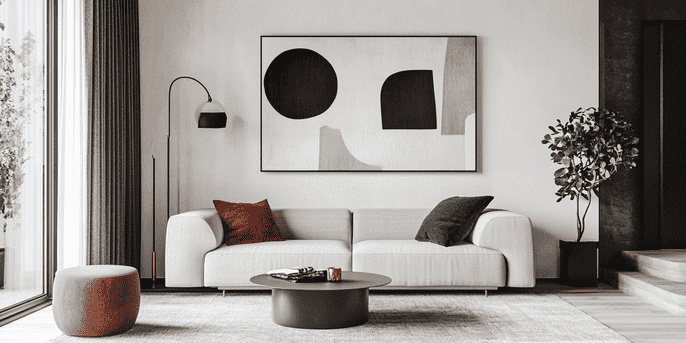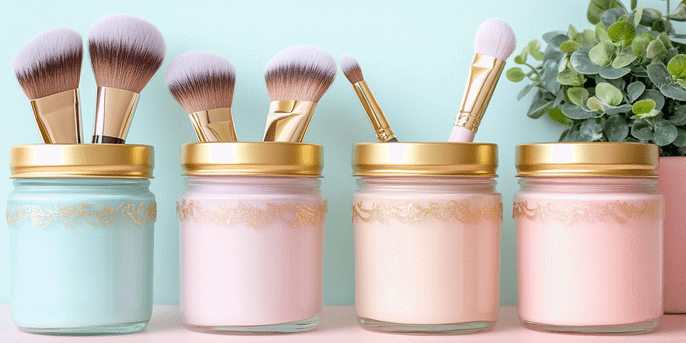Want to revamp your home without overspending? These 9 easy DIY projects will help you refresh your space while saving money. Perfect for UAE residents, these budget-friendly ideas utilize locally available materials and tools, making home improvement fun, affordable, and practical. Whether you’re upgrading your furniture, improving lighting, or adding a personal touch to your decor, these projects are simple yet effective. Follow these creative ideas and give your home the refresh it deserves!
Repurpose Old Furniture with a Fresh Coat of Paint

Outdated furniture doesn’t have to be discarded. A fresh coat of paint can completely transform an old table, dresser, or cabinet, making it look brand new. Repainting furniture is an affordable alternative to replacing it. With UAE’s wide range of heat-resistant and eco-friendly paints, this project is perfect for giving your home a stylish update. Plus, the process is simple and can be done in a day!
- Choose UAE-friendly paints: Opt for heat-resistant and low-VOC paints available at ACE Hardware. They are safe for indoor use and eco-friendly.
- DIY distressing technique: Create a vintage look with simple sanding and wax applications. This technique adds character to old furniture.
- Add new handles: Replace old knobs with modern, stylish ones for a fresh appeal. Metallic and wooden knobs add an elegant touch.
Cost: AED 50 - AED 200
Pro Tip: Use chalk paint for a smooth, no-primer finish—perfect for DIY beginners! It dries quickly and provides a matte look.
Create a DIY Vertical Garden
Urban living in the UAE means limited garden space, but a vertical garden allows you to incorporate greenery without using much room. Whether placed on a balcony, patio, or even indoors, this project brings fresh air into your home. A vertical garden also enhances aesthetics and supports sustainability by growing your own herbs and flowers.
- Use wooden pallets: Easily available at Carrefour UAE, they make great planters. Mount them on the wall or lean them against a balcony railing.
- Grow hardy plants: Opt for succulents, snake plants, or aloe vera, which thrive in UAE weather. These plants require minimal maintenance and water.
- Install drip irrigation: Saves water and keeps your plants hydrated effortlessly. Automated watering systems are convenient and eco-friendly.
Cost: AED 100 - AED 300
Pro Tip: Choose self-watering pots to reduce maintenance time. This is perfect for those with busy schedules.
Upgrade Your Lighting with LED Fixtures
Lighting can dramatically change the ambiance of a space. Replacing traditional bulbs with LED alternatives improves brightness, reduces electricity bills, and enhances energy efficiency. With smart lighting options available in the UAE, you can even control lights remotely and set moods for different times of the day.
- Smart LED strips: Available at Noon.com, perfect for mood lighting. They come in various colors and can be controlled via an app.
- Warm vs. cool lighting: Choose warm lights for cozy spaces and cool lights for productivity. Ideal for living rooms, bedrooms, and workspaces.
- Install motion-sensor lights: Helps save energy in lesser-used areas like hallways. These lights automatically turn off when not in use.
Cost: AED 50 - AED 150
Pro Tip: Use solar-powered LED lights for balconies and gardens to save on electricity costs. They charge during the day and provide illumination at night.
DIY Wall Art for Personalized Decor

Creating your own wall art adds a unique and personal touch to your home while saving money on expensive decor. Handmade artwork allows you to customize colors and styles to match your space. From painting to framed fabric pieces, there are endless possibilities to express your creativity.
- Canvas painting kits: Available on Amazon.ae for easy artistic expression. Even beginners can create stunning pieces with stencils.
- Washi tape geometric designs: Create striking patterns with zero paint mess. This is a renter-friendly way to add art to walls.
- Framed fabric pieces: Use UAE-inspired textile prints for a cultural touch. Fabric pieces are lightweight and can be changed seasonally.
Cost: AED 50 - AED 200
Pro Tip: Frame calligraphy prints of your favorite Arabic quotes for a meaningful touch. This adds cultural significance to your decor.
Revamp Your Balcony with Budget-Friendly Upgrades
A balcony can become your favorite relaxation spot with a few affordable upgrades. Whether you enjoy reading, sipping coffee, or spending time outdoors, making small changes can greatly enhance comfort and ambiance.
- Use outdoor rugs: Adds comfort and style; available at IKEA UAE. Weather-resistant rugs protect flooring and add coziness.
- Fairy lights for ambiance: Affordable lighting found at HomeBox UAE. String lights create a magical effect for evening relaxation.
- Hanging planters: Easy way to add greenery without cluttering the floor. They maximize space and enhance aesthetics.
Cost: AED 150 - AED 400
Pro Tip: Use bamboo blinds for shade and a natural aesthetic. They provide privacy while letting in natural light.
DIY Smart Storage Solutions
Clutter can make any home feel smaller and unorganized. Smart storage solutions help maximize space, reduce mess, and keep your home looking neat. From multipurpose furniture to DIY shelves, there are several ways to create more storage space without renovation. These ideas work well for both small and large homes.
- Floating shelves: Great for books and decor; easy to install. Available at Dragon Mart and IKEA UAE.
- Under-bed storage: Use storage boxes to keep extra linens and clothing neatly tucked away.
- Pegboard organizers: Perfect for kitchens, offices, or garages. Helps keep tools and essentials easily accessible.
Cost: AED 50 - AED 250
Pro Tip: Use vacuum storage bags to save even more space when storing seasonal clothing.
Transform Old Jars into Stylish Organizers

Reusing old jars is an excellent way to reduce waste while creating practical storage solutions for your home. These jars can be upcycled into holders for kitchen spices, bathroom essentials, or office supplies. By adding a touch of creativity, you can transform them into stylish pieces that blend seamlessly with your decor. This is an affordable and eco-friendly solution.
- Paint or wrap jars with jute rope: Gives a rustic, elegant look. Perfect for holding makeup brushes, cotton pads, or kitchen spoons.
- Use chalk labels for easy identification: Helps keep storage organized. Ideal for labeling spices, snacks, and coffee beans in the kitchen.
- Hang them on a wall-mounted rack: Saves counter space while adding charm. Great for storing small tools, craft supplies, or dried herbs.
Cost: AED 20 - AED 100
Pro Tip: Repurpose baby food jars for spice storage and use a magnet strip to mount them on a kitchen wall for a space-saving solution.
Make Your Own Scented Candles
Nothing adds warmth and coziness to a home like scented candles. Instead of purchasing expensive ones, making your own candles allows you to customize scents and designs while saving money. This DIY project is simple, fun, and makes for thoughtful gifts. You can choose from a variety of essential oils to create a relaxing atmosphere in your home.
- Use soy wax and essential oils: Available at Creative Minds UAE. Opt for lavender, vanilla, or oud for an inviting scent.
- Repurpose glass jars as candle holders: Eco-friendly and stylish. Old mason jars or teacups can make beautiful candle containers.
- Add dried flowers or colored wax layers: Enhances the visual appeal. Create layered candles with different hues for a designer look.
Cost: AED 70 - AED 200
Pro Tip: Use wooden wicks instead of traditional cotton wicks for a subtle crackling sound that adds to the ambiance.
Refresh Your Home with DIY Curtain Tiebacks
Curtain tiebacks can instantly elevate the look of your drapes without spending a fortune. Instead of buying expensive options, you can create your own tiebacks using materials found at home. From rope and beads to fabric scraps and decorative chains, this simple DIY project adds personality to any room while keeping curtains neatly pulled back.
- Use braided fabric strips: Matches your existing decor and is an easy sewing project. Works well with cotton or velvet materials.
- Decorate with beads or pearls: Adds a luxurious touch to any space. Wooden or metallic beads complement different curtain styles.
- Repurpose old necklaces as stylish holders: A creative and chic way to upgrade window decor. Works great with vintage or statement jewelry.
Cost: AED 30 - AED 100
Pro Tip: Use magnetic tiebacks for easy adjustments without the need for hooks or drilling into walls.
Conclusion
DIY projects are an excellent way to improve your home while saving money. From painting to ceiling windows, these upgrades enhance your space and cut costs.
Visit SavePlus for expert tips, curated coupons, and unbeatable savings. Enjoy your shopping experience and start transforming your home today!
FAQ
What are the easiest DIY home improvement projects for beginners?
Simple tasks like painting walls, changing light fixtures, and installing shelves are perfect for beginners. These projects require minimal tools and expertise.
How much can I save by doing home improvement projects myself?
On average, DIY projects save 40-60% of the total cost by eliminating labor fees. For instance, repainting can save thousands compared to hiring professionals.
Are DIY projects worth the effort and time?
Yes! DIY projects not only save money but also add value to your home. They allow customization and give you full control over the design and execution.
What tools do I need for basic home improvement projects?
Basic tools include a drill, paintbrushes, tape measure, level, screwdriver set, and a hammer. Many projects can be completed with just these essentials.
How can I find affordable materials for DIY projects?
Look for deals at thrift stores, online marketplaces, or discount home improvement retailers. SavePlus also offers coupons and discounts on tools and materials.






